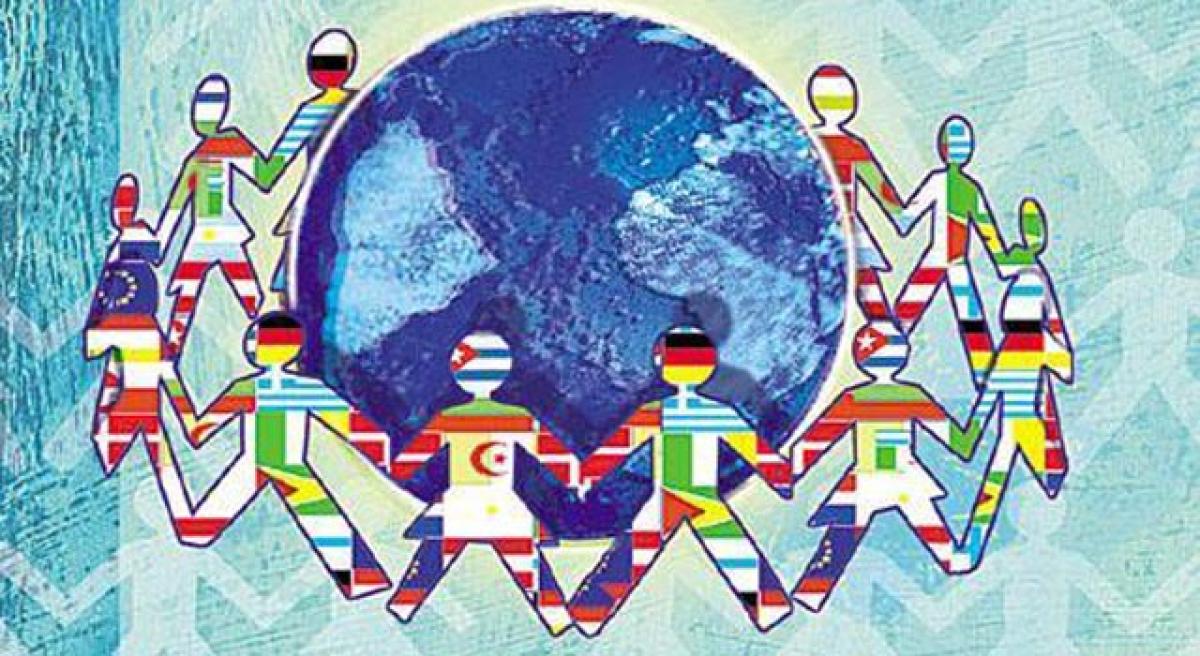Live
- Second phase randomization of EVMs is complete
- BJP confusing Matua voters though CAA notification: Mamata Banerjee
- IPL 2024: LSG might have to play the rest of the event without Mayank Yadav, says coach Justin Langer
- Two killed after colliding with a parked lorry
- PCB identifies the April 7- May 20 window for PSL 2025; to clash with IPL’s next season
- Viksit Bharat Ambassador event: Sri Sri Ravi Shankar heaps praise on PM Modi for Kashi facelift
- Women’s Hockey League: Haryana, Madhya Pradesh win on Day 5
- Indian Americans caution US university on demand to display 'flag of Kashmir'
- YS Sharmila worried over 'mental state' of brother Jagan
- PM Modi prays at Kanpur gurdwara along with CM Yogi
Just In

The video by Nawazuddin Siddiqui, a hugely talented actor and a personal favourite, showing that each religion of the world constitutes one-sixth of himself when he stays 100% an artist is good on emotional quotient in these troubled times.
The video by Nawazuddin Siddiqui, a hugely talented actor and a personal favourite, showing that each religion of the world constitutes one-sixth of himself when he stays 100% an artist is good on emotional quotient in these troubled times. However, he goes hopelessly wrong on the science when he quotes that it is proved by DNA testing on himself. His scriptwriters will certainly make all the geneticists of the world collectively cringe. It is doubtful if DNA testing can prove anything of such kind.
Adam Rutherford, in his brilliant book, ‘A Brief History of Everyone Who Ever Lived,’ talks about the ambitious Human Genome Project to decode the human genome. This was completed in the early 21st century and was expected to be the ultimate code of life and the answer to all our medical problems. Nothing of that sort happened however.
The Human DNA was seen to comprise only 20,000 genes, an extremely puny number, when the enormous complexity of the human mind is considered. It was a huge anti-climax, to say the least. The number of genes is almost the same in a grain of rice and the lowly worms. Many plant species have more number of genes than humans. Hence, there are a lot of things apart from the number which makes up for the complexity of species.
There are 3 billion base pairs in the entire chromosomal make-up of which only 3% go on to make genes. There was a controversy regarding what exactly defines a gene; but today, it means a unit which goes on to code for a specific protein. Hence, the protein coding genes are only 20,000 in number. But, recent studies have shown that the rest of the DNA has very important properties in modulating the effects of genes and acting as switches; they can be no longer considered ‘junk’.
We simply do not know about them presently, but progress is on at a breakneck speed. The 99.9% of DNA being common to all humans and we all being same at the level of DNA is an important but meaningless factoid according to the author. 0.1% of 3 billion base pairs is still a huge number which accounts for so many differences across various groups and individuals in the world.
Hence, we are all the same and the same time, everyone is unique. There has never been one like you; and never again in the history of the Universe will there be one like you. That certainly will warm the heart to good levels! A disturbing feeling, however, ensues through the book as one realises the unity of our species and yet there have been so many futile wars and fights. Fighting other species is part of the evolutionary mechanisms; but fighting our own seems a little troubling.
The book traces the ancestry of all humankind. A few thousand years back, a few thousand men were the ancestors of all people who are living now. Hence, a Chinese, a Russian, an Indian, a European, an African, an Arab are all living in your and my DNA as information, which may or may not be expressed.
We are all related and not only that; we are all related to the Neanderthals too, whom we successfully eliminated or integrated. About 2-3% of genes belong to the Neanderthals. Yes, we procreated with them. Humans have been certainly very promiscuous. Genes can track the movements of species across various geographical locations; and it is now accepted that we all came out of Africa.
The humankind presently populating the entire globe started as a small group of people in Africa who started walking. The unifying message of the book is we are all one; but each one is unique. What a wonderful way to celebrate! One thing which the author forcefully makes clear is that, for genes, race does not exist.
The ancestry of every person alive today stops at a few thousands of people some 10,000 years back. We are all cousins and by looking at genes, no kind of race can be predicted or profiled. However, we as humans with our colossal human minds have been doing that knowingly and unknowingly. Our ancestors were ignorant of genetics; we are not, yet we keep dividing in the name of race.
Genetics and DNA can be used to make even more powerful unifying messages for humankind by the celebrities than the present one by Nawazuddin. It is a decent attempt, but I only wished that his writers had read better science.
By Dr Pingali Gopal

© 2024 Hyderabad Media House Limited/The Hans India. All rights reserved. Powered by hocalwire.com







